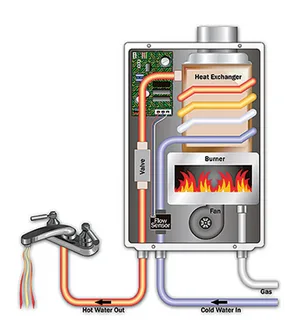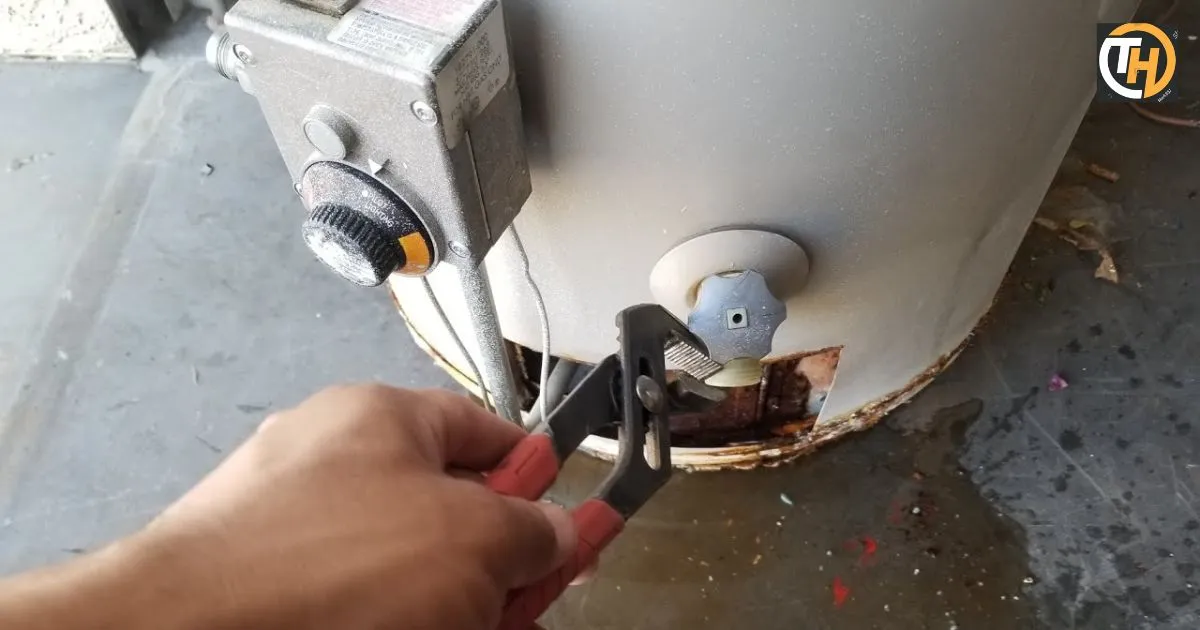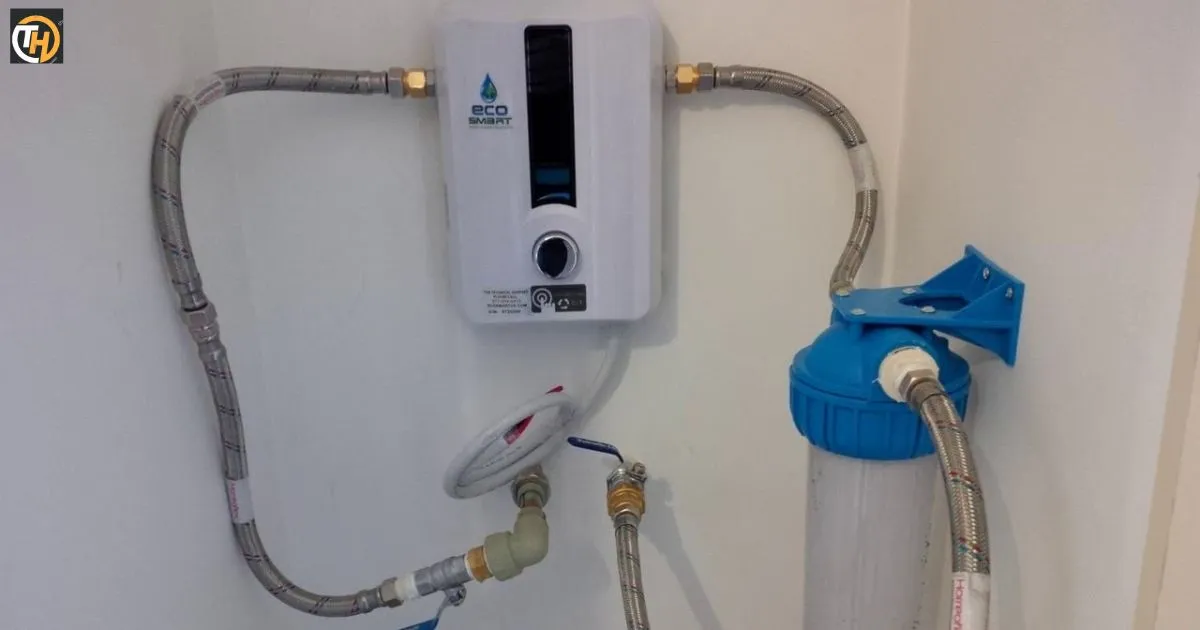A non-condensing tankless water heater is a cutting-edge solution for on-demand hot water needs. Unlike traditional water heaters that store and continuously heat a large amount of water, non-condensing tankless water heaters provide hot water instantly, heating it as it flows through the unit.
Imagine having hot water at your fingertips the moment you turn on the tap – no more waiting for a storage tank to heat up, and no more concerns about running out of hot water during a long shower. Non-condensing tankless water heaters revolutionize the way we experience hot water by providing an instantaneous and continuous supply.
The functionality of non-condensing tankless water heaters goes beyond just instant hot water. These units operate by heating water directly without relying on the condensation process, which sets them apart from their condensing counterparts.
What’s a Non-Condensing Tankless Water Heater?
A noncondensing tankless water heater operates without utilizing the condensation process. Instead, the flue gases are expelled at a higher temperature, and the unit does not extract as much heat from the combustion process.
While still efficient, noncondensing units may have a lower efficiency compared to their condensing counterparts. These units are suitable for certain applications but may produce higher exhaust temperatures and waste some heat.
What is Condensation in a Tankless Water Heater?
Condensation in a tankless water heater refers to the process by which water vapor in the flue gases is cooled and converted back into liquid form. In tankless water heaters, this occurs when the unit extracts heat from the combustion process, allowing for greater efficiency.
The condensed water is then typically drained away from the unit. Understanding condensation is pivotal for appreciating the distinction between noncondensing and condensing tankless water heaters.
How Does a Non-Condensing Tankless Water Heater Work?
Overview of the Heating Process
Noncondensing tankless water heaters operate by heating water on demand, providing hot water only when needed.
The process begins when a hot water tap is turned on, triggering the activation of the water heater.
Absence of Condensation in the Heating Mechanism
Unlike condensing tankless water heaters, noncondensing models do not utilize the condensation process. Condensation, where water vapor in the flue gases is converted back to liquid, is not a part of the heating mechanism in non-condensing units.
Key Components of NonCondensing Tankless Water Heaters
Heat Exchanger
The heat exchanger is a vital component responsible for transferring heat from the burner to the water. It ensures efficient heating by maintaining a constant flow of hot water as it passes through.
Burner System

The burner system is the source of heat in the water heater, typically powered by natural gas or propane. It ignites to generate the heat needed to raise the water temperature as it flows through the heat exchanger.
Water Flow Sensor
The water flow sensor detects when hot water is required, initiating the heating process. It ensures that the water heater only activates when there is a demand for hot water, contributing to energy efficiency.
Advantages of NonCondensing Tankless Water Heaters
CostEffectiveness
- Noncondensing tankless water heaters are generally more affordable upfront compared to their condensing counterparts.
- The initial investment for purchasing and installing these units is often lower, making them an economical choice for budget-conscious homeowners.
Simplicity in Design
- These water heaters boast a simple and straightforward design, contributing to their ease of use.
- The absence of a condensation process simplifies the overall mechanism, making noncondensing units less complex and more accessible for homeowners.
Lower Maintenance Requirements
- Noncondensing tankless water heaters typically have lower maintenance requirements.
- The simplicity of their design translates to fewer components that may require attention, reducing the need for frequent and extensive maintenance tasks.
Limitations and Considerations
Energy Efficiency Comparison with Condensing Models
- Noncondensing tankless water heaters generally have lower energy efficiency compared to condensing models.
- The absence of a condensation process in noncondensing units may result in a slightly lower efficiency, particularly in extracting heat from the flue gases.
Applicability in Specific Environments
- Consider the specific environment and hot water demands of your household before opting for a noncondensing tankless water heater.
- While these units can be suitable for various applications, their effectiveness may vary based on factors such as climate, water hardness, and usage patterns. Evaluate your specific needs to ensure the chosen water heater aligns with your requirements.
Installation and Venting Requirements
Proper Ventilation for NonCondensing Units
Adequate ventilation is crucial for the safe and efficient operation of noncondensing tankless water heaters. Proper venting ensures the expulsion of combustion gases, preventing potential hazards and contributing to the longevity of the unit.
Installation Guidelines for Optimal Performance
Follow manufacturer guidelines meticulously during the installation of a noncondensing tankless water heater. Adhering to recommended installation practices is paramount to achieving optimal performance and ensuring the unit operates at its best efficiency.
Popular NonCondensing Models in the Market
Highlighting Notable Brands
Several reputable brands offer popular noncondensing tankless water heater models in the market. Notable brands known for their quality and reliability include [Brand A], [Brand B], and [Brand C].
Comparing Features and Capacities
When exploring noncondensing models, it’s essential to compare features and capacities to find the best fit for your needs. Consider factors such as flow rate, temperature rise, energy efficiency ratings, and additional features offered by different models. This comparison ensures that the selected unit aligns with your specific hot water requirements.
Maintenance Tips for NonCondensing Tankless Water Heaters
Regular Flushing Procedures

Implement a routine flushing schedule to maintain the efficiency of your noncondensing tankless water heater. Flushing helps remove mineral deposits and debris that may accumulate over time, ensuring a smooth flow of water and preventing potential issues.
Addressing Common Issues
Stay vigilant for common issues that may arise with noncondensing tankless water heaters. Issues such as reduced water flow, inconsistent temperature, or error codes on the unit should be promptly addressed.
Refer to the manufacturer’s manual for troubleshooting guidance or seek professional assistance if needed. Regular maintenance and timely resolution of issues contribute to the longevity and reliable performance of the unit.
Environmental Impact
Energy Consumption Considerations
- When assessing the environmental impact of noncondensing tankless water heaters, it’s essential to consider their energy consumption.
- These units typically have moderate to high energy efficiency, reducing overall energy consumption compared to traditional tank-style water heaters.
- This contributes to lower greenhouse gas emissions and a smaller environmental footprint.
LongTerm Sustainability Perspectives
- Noncondensing tankless water heaters can offer long-term sustainability benefits.
- With proper maintenance and energy-efficient operation, these units contribute to sustainability by minimizing resource usage and reducing the need for frequent replacements.
- Considering the long lifespan of tankless water heaters, the environmental impact over time can be significantly lower than less efficient alternatives.
Consumer Reviews and Experiences
Gathering Insights from Users
- Understanding the experiences of consumers provides valuable insights into the performance of noncondensing tankless water heaters.
- Read consumer reviews on reputable platforms and forums to gain a comprehensive understanding of the strengths and potential drawbacks of specific models.
- Real-life experiences offer practical insights that can aid in decision-making.
Addressing Common Concerns
- Take note of common concerns raised by users in consumer reviews and forums.
- Addressing these concerns helps prospective buyers make informed decisions and prepares them for potential challenges.
- Whether it’s related to installation, performance, or durability, addressing common concerns ensures a more transparent understanding of what to expect from a noncondensing tankless water heater.
Initial Investment vs. LongTerm Savings
- Conduct a thorough cost analysis when considering a noncondensing tankless water heater.
- While the initial investment may be lower compared to condensing models, evaluate the long-term savings in energy costs.
- Consider factors such as energy efficiency and the unit’s lifespan to determine the overall cost-effectiveness of the investment.
Affordability for Different Budgets for Non-condensing Tankless Water Heater
- Noncondensing tankless water heaters offer affordability for a range of budgets.
- With various models available, homeowners can find units that align with their financial constraints while still providing an efficient and reliable hot water supply.
- Explore different brands and models to identify the best balance between affordability and features.
Comparative Analysis with Condensing Models
- Conduct a comparative analysis between noncondensing and condensing tankless water heaters.
- Assess the differences in performance, energy efficiency, and upfront costs.
- Understanding the distinctions helps in making an informed decision based on your specific requirements and budget constraints.
Highlighting Differences in Performance
- Highlight the performance differences between non-condensing and condensing models.
- Consider factors such as energy efficiency, maximum flow rate, and temperature rise.
- Understanding how each type performs in various scenarios ensures that you select the water heater that best meets your hot water demands.
Choosing the Right Type for Your Needs
Emerging Technologies in NonCondensing Units
- Stay informed about the latest technologies being integrated into noncondensing tankless water heaters.
- Manufacturers often introduce innovations to enhance performance, energy efficiency, and user experience.
- Explore units with features like smart controls, self-diagnostic systems, and improved heating elements to stay at the forefront of industry advancements.
Future Prospects in Water Heater Design
- Consider the future prospects of water heater design when exploring non-condensing units.
- The industry continually evolves, and anticipating upcoming innovations can guide your decision-making process.
- Look for models that align with potential future advancements, ensuring your investment remains relevant and efficient.
Guidelines for Choosing a Non-Condensing Tankless Water Heater
- Establish guidelines to streamline the process of choosing a noncondensing tankless water heater.
- Consider factors such as flow rate, temperature rise, energy efficiency ratings, and available features. These guidelines act as a roadmap, helping you navigate the market and select a unit that aligns with your specific hot water needs.
Factors to Consider Before Purchase
- Before purchasing a noncondensing tankless water heater, carefully evaluate several factors.
- Consider the unit’s capacity, energy efficiency, installation requirements, and warranty terms. Taking these factors into account ensures that the selected unit meets your expectations and provides reliable hot water on demand.
Matching the Unit to Your Hot Water Demands
- Ensure the selected noncondensing unit aligns with your household’s hot water demands.
- Calculate the flow rate needed to accommodate simultaneous hot water usage and assess the temperature rise capability.
- Matching the unit to your specific demands ensures a consistent and satisfactory hot water supply.
Here’s a table summarizing the basic purpose of an article on “What Is a NonCondensing Tankless Water Heater?” with key points and descriptions:
| Purpose | Key Points | Description |
| Definition | Noncondensing tankless water heaters | Noncondensing tankless water heaters are a type of ondemand water heating system. |
| How they differ from condensing units | They differ from condensing units in that they do not utilize condensation to maximize efficiency. | |
| Operation | Direct heating of water | These heaters directly heat water as it flows through the unit, providing hot water on demand. |
| Efficiency | Lower efficiency compared to condensing | Noncondensing units generally have lower efficiency as they don’t recover heat from exhaust gases. |
| Venting | Requires conventional venting | They typically require conventional venting, expelling combustion gases through a vent pipe. |
| Installation | Simpler installation process | Installation is often simpler due to the absence of complex condensate removal systems. |
| Maintenance | Generally lower maintenance requirements | They may have lower maintenance needs since there’s no condensate to manage and maintain. |
This table provides a brief overview of the article’s focus on noncondensing tankless water heaters, outlining key points and offering a description for each aspect.
Conclusion
Navigating the realm of noncondensing tankless water heaters involves weighing factors like cost, efficiency, and long-term sustainability. By understanding their working principles, advantages, and limitations, consumers can make informed decisions that align with their specific hot water needs.
Regular maintenance, consumer insights, and consideration of emerging trends contribute to optimizing the performance and environmental impact of these water heaters. The choice between noncondensing and condensing models should be based on a holistic assessment, considering not only immediate budget constraints but also long-term energy savings.











